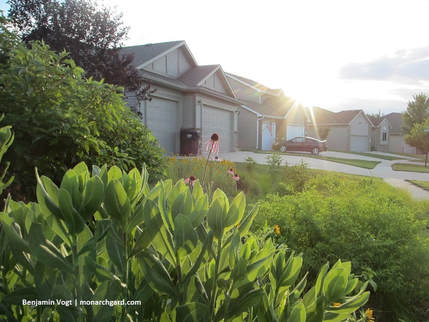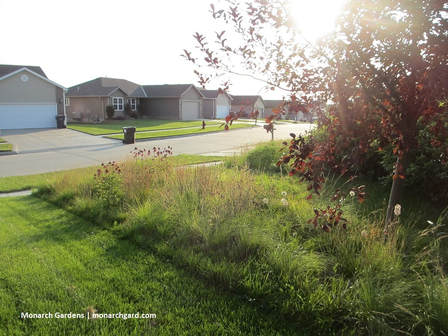1) Matching plants to the site
At the very top of creating a landscape that requires less work than many traditional designs is carefully matching plants to your garden areas. This means going beyond the limited information plant tags provide and consulting with several reliable online and print sources. What soil will it do well in? How big does the plant get in your specific soil, light, and moisture levels? How does it spread and in what time frame? If you’re gardening with plants native to your location you’re already one step ahead of the game, as they will be more adapted to your climate and weather if you site them correctly at home. Of course, you’ll also not want to use a shrub that gets large too close to a structure, or something that will weep or flop near a sidewalk. You’d be surprised – or maybe you wouldn’t – how often we don’t take into account what a plant will do in 5 to 10 years, so plan ahead.
When you’re doing research on matching plants to your site conditions, you’ll also want to learn how they play with others. You wouldn’t want to place an aggressive species next to a behaved clumping plant, or one that gets super tall next to a more modest specimen. Thinking about roots is key, too: placing a grass with a fibrous and shallow root zone along with a milkweed or coneflower with a deep taproot is smart design, as neither will be competing for the same soil resources (the same rule applies for bulbs). And then there are plants which add fertilizer to the soil in the form of nitrogen, so planting them near other plants you know are heavy feeders is a good idea. Such free-fertilizer plants include Baptisia spp, Dalea spp, Lespedeza spp, and Cassia / Senna spp.
3) Designing in layers
Do you like fertilizing and mulching? If so, stop reading now. Otherwise, let the plants do that work for you just as they do in nature. For most herbaceous perennials, annuals, grasses, and sedges you can ignore plant spacing suggestions and place them 10-12” apart. The closer the better so they knit together sooner, which will impede weeds starting in year one. As the close-knit plants shade out weed seedlings they also shade the soil, which conserves soil moisture – this is what we call green mulch, or plants as the living mulch. We can take it further and design our gardens in layers that will further inhibit weeds and cool the soil. Start with a majority number of groundcover or shorter plants about one foot tall (50-60%), then have some groups of taller 2-4 foot plants (30-40%), followed by even smaller groups of 5-8 foot plants including small shrubs and trees (10-20%). These layers reduce maintenance like weeding, watering, and fertilizing while also providing ample wildlife habitat.
Hopefully you wait until early to mid spring to cut down your garden, as this not only helps plants overwinter in colder areas, but provides shelter and hibernating spaces for birds and beneficial insects like butterflies, spiders, bees, and beetles. When you do cut down the garden in spring leave all that detritus on the ground where it falls. These stems provide all the nutrients plants will need, and in a month or so new plant growth will cover up the seeming mess. Come winter, soil organisms will have decomposed the vast majority of these cuttings adding a new layer of fertile soil to your beds. Ah, nature!
5) Let plants teach you
As gardeners we design. We put specific plants in specific places because we want them there. And sometimes, if we’re lucky and have done our research, the plants will thrive where we put them. But sometimes they will die, and often they will move. Don’t be dismayed if they move to a place you wish they weren’t, because what the plant is doing is teaching you what it really wants and needs – and you ought to pay attention and be humble about it. Success in gardening can often mean being a sort of plant whisperer who isn’t a helicopter parent. In other words let the plants find their way in the world, then help them thrive in that world they’ve chosen. In fact, if you really what to have some fun, plan your garden in anticipation of plants moving, dying, and overall ebbing and flowing. Each year the design will change and excite you in new ways. Choose species that self sow to varying degrees or spread a bit by runners, and use species like black-eyed susan (Rudbeckia hirta) that tend to be short lived in the garden, giving way to more mature species as the years progress.
To learn more about sustainable wildlife gardening, check out some 200 articles or try one of these 5 online classes.




 RSS Feed
RSS Feed

